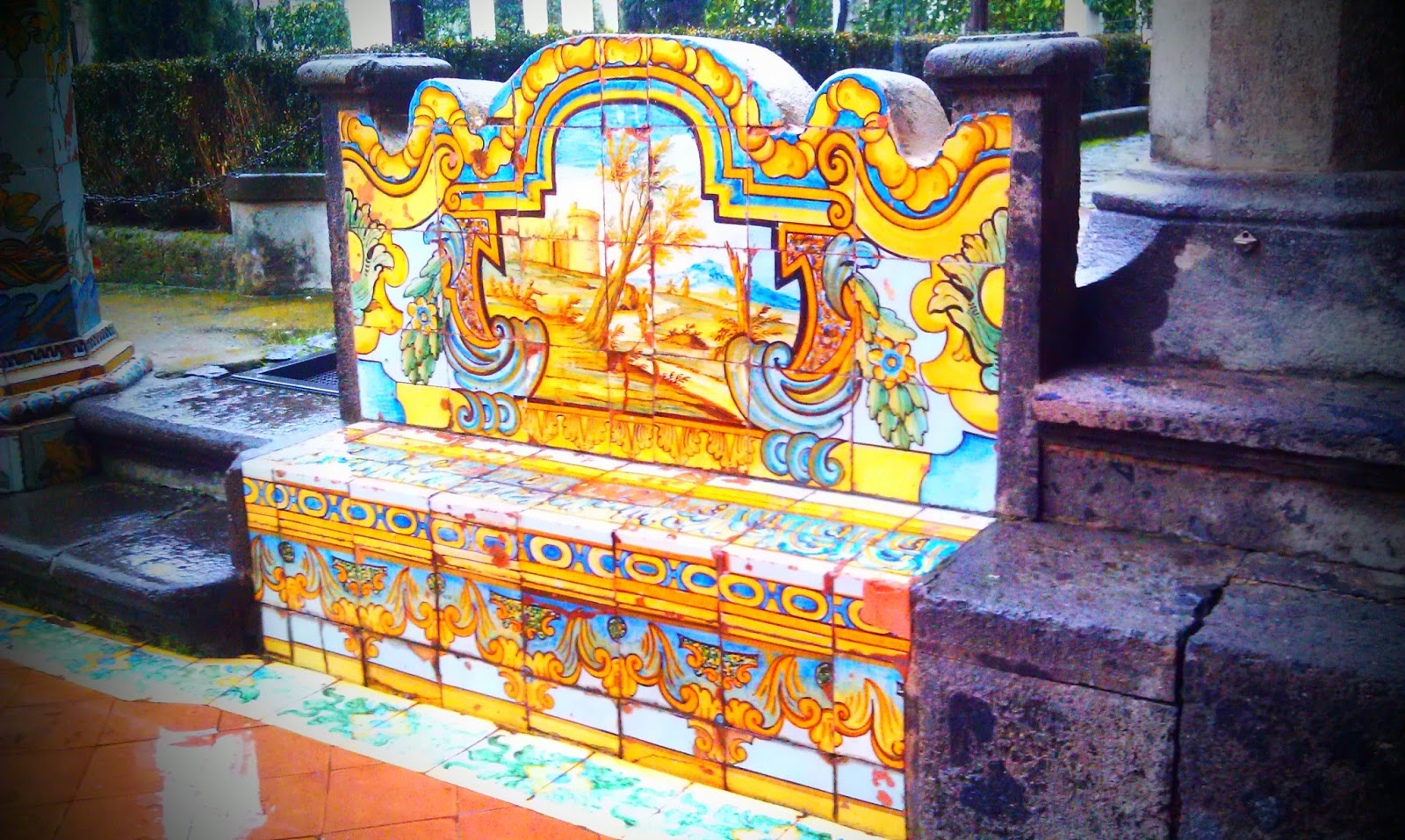“A volte penso addirittura che Napoli possa essere
ancora l'ultima speranza che resta alla razza umana” scrive Luciano De
Crescenzo. Dopo questa giornata partenopea non posso che dargli ragione. Ogni
giorno sulle pagine dei giornali si leggono notizie buie, che aggiungono
sconforto alle difficoltà che ognuno di noi incontra ogni giorno sul suo
percorso. Ma a Napoli l’atmosfera che si respira e’ diversa, nonostante si sia
attorniati da palazzi che necessiterebbero di restaurazione e si rischi di
pestare il ricordino di un cane ad ogni passo, Napoli ti meraviglia.
Nell’immaginario collettivo, o almeno nel mio, Napoli è sole e panni colorati
stesi ad asciugare, sono la vista del Vesuvio e del mare, è caffè, pizza e
presepi. Nel giorno in cui la città ha ospitato me, il sole non si è fatto
vedere nemmeno per un momento, e la pioggia ha dato il ritmo a una giornata che
nonostante il meteo avverso ha saputo essere magica. L’obiettivo mio e di
Giovanna, la mia guida campana, era di raggiungere il Cristo Velato, e di
vedere tutto quello che ci avrebbe incuriosito durante il percorso. Abbiamo
imboccato Spaccanapoli partendo da Porta Capuana, fermandoci a visitare il
maestoso Duomo, con la splendida cappella dedicata a San Gennaro

Una volta uscite, la pioggia ci ha nuovamente accolte
con un po’ troppa veemenza. E’ stata d’obbligo dunque una tappa caffè (e
immancabile cornetto) per recuperare le energie. Una volta ripreso a
passeggiare, ci siamo imbattute nella Napoli Sotterranea, e abbiamo colto al
volo l’occasione di provare l’ebbrezza di essere speleologhe per un’ora. Siamo
scese di 40 mt nel sottosuolo, scoprendo cavità e cunicoli nascosti che si
snodano sotto la città. Cava di tufo durante il periodo greco, acquedotto e
cisterna nel periodo romano, il sottosuolo di Napoli si scopre essere tanto
pieno di storia quanto i vicoli e palazzi in superficie. Armate di lume di
candela ci siamo avventurate per cunicoli strettissimi, progettati per portare
l’acqua da una cisterna all’altra. E abbiamo provato a immaginare come dovesse
essere la giornata di coloro che durante la 2 guerra mondiale trovavano rifugio
in questi spazi per salvarsi ai bombardamenti aerei.
Altro interessante particolare di Napoli è che le sue
epoche storiche si fondono e si trasformano l’una sull’altra. Come nel caso
dell’antico teatro romano dove recitò Nerone, che ora è in parte fondamenta per
i palazzi medievali sorti nei secoli successivi, e al quale si accede da una
botola posta sotto un letto di un basso napoletano.
Tutto questo esplorare ha decisamente messo appetito. E
come si può rinunciare ad assaggiare la famosa pizza napoletana? Margherita,
ovviamente. Indimenticabile e ottimo carburante per poter proseguire la visita’
alla città.
Il monastero di Santa Chiara è a soli pochi passi dalla
pizzeria. Il portico in stile arabeggiante mi ricorda immediatamente Siviglia.
Ed è un vero peccato che la pioggia incessante non permetta di godersi il
cortile interno come meriterebbe.
Uscite dal monastero chiediamo indicazioni per trovare
il Cristo Velato, come d’altronde abbiamo fatto per tutta la giornata. Ogni
napoletano a cui chiediamo indicazioni si rivela incredibilmente disponibile a
spiegarci in dettaglio la strada che dobbiamo seguire, con tanto di
scorciatoie. E’ quasi come chiedere indicazioni ad un amico.
E così arriviamo alla cappella di San Severo, e al
Cristo Velato. Vedere dal vivo un’opera d’arte così stupefacente è un’emozione
che difficilmente si scorda. Anche la maglia di rete del Disinganno è difficile
crederla di marmo. E’ interessante vedere quello che gli artisti del passato
sono riuscita a ricavare da della pietra, dal marmo. Queste statue sembrano
vive, sembrano respirare e comunicare con chi le ammira.
Un’ultima tappa è d’obbligo, prima di lasciare Napoli,
ed è Piazza del Plebiscito e la vista del Vesuvio dal lungomare. Piove ancora
ma il paesaggio ha comunque il suo fascino.
Una giornata piena di arte come questa non è difficile
trascorrerla nelle città italiane. Ciò che l’ha resa speciale sono i napoletani
con il loro calore, la loro parlata vivace e solare, la loro disponibilità nel
rispondere alle mie domande. In questa città mi sono sentita accolta a braccia
aperte come mai mi era successo prima. La Storia che ha attraversato e
modellato la città, inglobando l’antico col nuovo, e le varie culture che si
sono susseguite nel dominio della regione hanno reso Napoli un posto davvero
speciale, davvero un esempio, un lume e una speranza per l’umanità’.


























